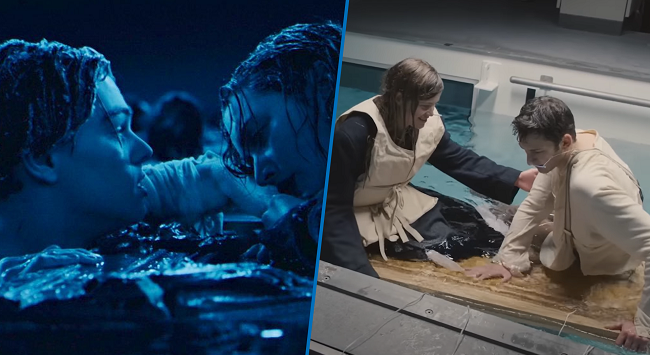Cameron and a team of scientists re-staged one of Titanic’s final scenes to test the theory that Jack could’ve survived on the door next to Rose in “dangerous levels of freezing water.”
In the words of (old) Rose, “it’s been 84 years” since James Cameron was able to leave the house without being questioned about the long-standing theory that Jack (Leonardo DiCaprio), the love of his life, could have survived the Titanic’s sinking if he had just gotten on that floating door next to Rose (Kate Winslet), near the end of his Best Picture-winning epic Titanic.
In the upcoming National Geographic special Titanic: 25 Years Later With James Cameron, the 68-year-old director puts the rumors to rest before the movie’s Feb. 10 theatrical re-release. In it, Cameron and a group of scientists try to recreate the incident and test four different hypotheses in which Jack actually climbed onto the wreckage as well.
In the initial round, Cameron notes that “Jack and Rose are able to get on the raft, but now they’re both submerged in dangerous levels of freezing water” in the video above.
Then, in order to increase the actors’ chances of survival, the team positions both actors on the raft so that their upper bodies—and vital organs—are lifted out of the water.
“Out of the water, [his body’s] violent shaking was helping him,” Cameron continues. “Projecting it out, he could’ve made it pretty long. Like, hours.”
The actors take on all of the physically demanding tasks Jack and Rose underwent before discovering the floating door for the final test, including the scene in which a fellow passenger tries to use Rose as a floatation device but is met by a powerful blow from Jack’s fist. The Rose in the experiment gives Jack a life jacket for extra protection, which is another extra moment they add that wasn’t in the movie.
“He’s stabilized,” Cameron observes. “He got into a place where if we projected that out, he just might’ve made it until the lifeboat got there. Jack might’ve lived, but there’s a lot of variables. I think his thought process was, ‘I’m not going to do one thing that jeopardized her,’ and that’s 100 percent in character.”
Fans of Titanic have long debated the issue, and Winslet offered her opinion while on tour to promote her part in director James Cameron’s most recent wet and wild adventure, Avatar: The Way of Water.
“I have to be honest: I actually don’t believe that we would have survived if we had both gotten on that door. I think he would have fit, but it would have tipped and it would not have been a sustainable idea,” Winslet said in December on the Happy Sad Confused podcast. “So, you heard it here for the first time. Yes, he could have fit on that door, but it would not have stayed afloat. It wouldn’t.”
Unfortunately, however, it was never going to end well for Jack.
Titanic: 25 Years Later With James Cameron — celebrating 25 years since the film’s Best Picture victory at the 1998 Oscars — premieres Sunday at 9 p.m. ET on National Geographic, and streams the next day on Hulu. Watch Cameron test the floating door theory in the clip above.




